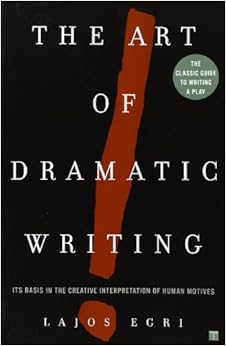
The Art Of Dramatic Writing: Its Basis In The Creative Interpretation Of Human Motives Download Free (EPUB, PDF)

Learn the basic techniques every successful playwright knows Among the many "how-to" playwriting books that have appeared over the years, there have been few that attempt to analyze the mysteries of play construction. Lajos Egri's classic, The Art of Dramatic Writing, does just that, with instruction that can be applied equally well to a short story, novel, or screenplay. Examining a play from the inside out, Egri starts with the heart of any drama: its characters. All good dramatic writing hinges on people and their relationships, which serve to move the story forward and give it life, as well as an understanding of human motives -- why people act the way that they do. Using examples from everything from William Shakespeare's Romeo and Juliet to Henrik Ibsen's A Doll's House, Egri shows how it is essential for the author to have a basic premise -- a thesis, demonstrated in terms of human behavior -- and to develop the dramatic conflict on the basis of that behavior. Using Egri's ABCs of premise, character, and conflict, The Art of Dramatic Writing is a direct, jargon-free approach to the problem of achieving truth in writing.

Paperback: 320 pages
Publisher: Touchstone; Revised edition (February 15, 1972)
Language: English
ISBN-10: 0671213326
ISBN-13: 978-0671213329
Product Dimensions: 5.5 x 1 x 8.4 inches
Shipping Weight: 10.6 ounces (View shipping rates and policies)
Average Customer Review: 4.0 out of 5 stars See all reviews (128 customer reviews)
Best Sellers Rank: #41,031 in Books (See Top 100 in Books) #5 in Books > Arts & Photography > Performing Arts > Theater > Playwriting #5 in Books > Reference > Writing, Research & Publishing Guides > Writing > Play & Scriptwriting #39 in Books > Textbooks > Humanities > Performing Arts > Theater

Well, I read this book recently after reading god knows how many screenwriting books. Some of them are quite repetitive aren't they?! The thing that I've found is that there are a lot of books out there that explain the three-act structure by saying you have a set-up, then you have your turning points, your climax, your resolution blah blah blah. Thing is we all instinctively know we need this stuff in our plays and screenplays but what's hard as a writer is actually figuring out what these should be. What makes a good turning point, what makes a good resolution etc? If you want to find out, I strongly suggest you read this book.I found this book (along with Robert McKee's 'Story') the most useful out of the many (screenwriting) books I've read because he gets into the nitty gritty hard stuff. He makes you think about how important the premise is. I disagree with some of the reviews of this book on this site that say that Egri says you have to know your premise from the outset, he doesn't say that, what he does say is that you have to know it clearly at some stage in writing your script and this is true because we go to films to find something out and all the pieces have to fit together or you'll say something like 'The second half of the movie dragged', 'Why did she do that? That wasn't in character' or 'The movie tried to prove too many points all at once' and so on.The more I write scripts, the more I realise that it's all about planning and architecture because pacing is everything unlike novels etc.In particular, the most useful takeout from this book is that your premise has to match your character and story. He goes into detail using 'A Doll's House' as an example.
The Art Of Dramatic Writing: Its Basis in the Creative Interpretation of Human Motives Writing: A Guide Revealing The Best Ways To Make Money Writing (Writing, Writing Skills, Writing Prompts Book 1) The Art of Forgery: The Minds, Motives and Methods of the Master Forgers Journey into Darkness: Follow the FBI's Premier Investigative Profiler as He Penetrates the Minds and Motives of the Most Terrifying Serial Criminals Nursing: Human Science And Human Care (Watson, Nursing: Human Science and Human Care) The Playwright's Guidebook: An Insightful Primer on the Art of Dramatic Writing The Art of Dramatic Writing Writing Romance: The Top 100 Best Strategies For Writing Romance Stories (How To Write Romance Novels, Romance Writing Skills, Writing Romance Fiction Plots, Publishing Romance Books) Biomechanical Basis of Human Movement Biomechanical Basis of Human Movement, 3rd Edition Biopsy Interpretation of the Gastrointestinal Tract Mucosa: Volume 1: Non-Neoplastic (Biopsy Interpretation Series) Biopsy Interpretation of the Gastrointestinal Tract Mucosa: Volume 2: Neoplastic (Biopsy Interpretation Series) Personal Umbrella Coverage Guide - Interpretation and Analysis: Interpretation and Analysis Wiley Not-for-Profit GAAP 2014: Interpretation and Application of Generally Accepted Accounting Principles (Wiley Not-For-Profit GAAP: Interpretation ... of GenerallyAccepted Accounting Principles) Wiley GAAP: Interpretation and Application of Generally Accepted Accounting Principles 2011 (Wiley GAAP: Interpretation & Application of Generally Accepted Accounting Principles) Creative Haven Midnight Garden Coloring Book: Heart & Flower Designs on a Dramatic Black Background (Adult Coloring) Creative Haven Flower Mandalas Coloring Book: Stunning Designs on a Dramatic Black Background (Adult Coloring) Creative Haven Midnight Forest Coloring Book: Animal Designs on a Dramatic Black Background (Adult Coloring) Creative Haven Magical Mehndi Designs Coloring Book: Striking Patterns on a Dramatic Black Background (Adult Coloring) The Dramatic Writer's Companion: Tools to Develop Characters, Cause Scenes, and Build Stories (Chicago Guides to Writing, Editing, and Publishing)



